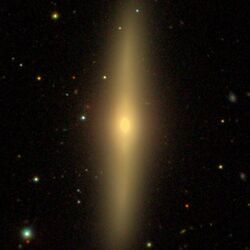Astronomy:NGC 4026
| NGC 4026 | |
|---|---|
 NGC 4026 by SDSS | |
| Observation data (J2000 epoch) | |
| Constellation | Ursa Major |
| Right ascension | 11h 59m 25.2s[1] |
| Declination | +50° 57′ 42″[1] |
| Redshift | 985 ± 5 km/s[1] |
| Distance | 52 ± 14 Mly (16.0 ± 4.4 Mpc)[1] |
| Apparent magnitude (V) | 10.7 |
| Characteristics | |
| Type | S0 [1] |
| Apparent size (V) | 5.2′ × 1.3′[1] |
| Other designations | |
| UGC 6985, MCG +09-20-052, PGC 37760[1] | |
NGC 4026 is an edge-on lenticular galaxy in the constellation Ursa Major. It is located at a distance of circa 50 million light years from Earth, which, given its apparent dimensions, means that NGC 4026 is about 80,000 light years across. It was discovered by William Herschel on April 12, 1789.
The galaxy hosts a supermassive black hole with estimated mass 108.33±0.109 (166-275 million) M☉.[2]
Nearby galaxies
NGC 4026 belongs to M109 Group,[3] the largest subgroup of galaxies with the Ursa Major Cluster.[4] In the vicinity of NGC 4026 lie some low surface brightness spiral galaxies, UGC 6917 (42 arcminutes from NGC 4026), UGC 6922 (26 arcminutes from NGC 4026) and UGC 6956 (10 arcminutes from NGC 4026).[5]
NGC 4026 appears disturbed in HI imaging, with a filament extending southward. The mass of HI in NGC 4026 is below 0.71 × 108 M⊙.[5] The total HI mass in NGC 4026, UGC 6956 and the HI filament is estimated to be 7.94 × 108 M⊙.[6] This phenomenon has been studied and evidence implies the presence of tidal forces and tidal interactions between the galaxies. [7]
References
- ↑ 1.0 1.1 1.2 1.3 1.4 1.5 1.6 "NASA/IPAC Extragalactic Database". Results for NGC 4026. http://ned.ipac.caltech.edu/cgi-bin/nph-objsearch?objname=NGC+4026.
- ↑ Johannsen, Tim; Psaltis, Dimitrios; Gillessen, Stefan; Marrone, Daniel P.; Özel, Feryal; Doeleman, Sheperd S.; Fish, Vincent L. (10 October 2012). "Masses of Nearby Supermassive Black Holes with Very Long Baseline Interferometry". The Astrophysical Journal 758 (1): 30. doi:10.1088/0004-637X/758/1/30. Bibcode: 2012ApJ...758...30J.
- ↑ Makarov, Dmitry; Karachentsev, Igor (21 April 2011). "Galaxy groups and clouds in the local (z~ 0.01) Universe". Monthly Notices of the Royal Astronomical Society 412 (4): 2498–2520. doi:10.1111/j.1365-2966.2010.18071.x. Bibcode: 2011MNRAS.412.2498M. http://www.sao.ru/hq/dim/groups/galaxies.dat. Retrieved 2 August 2017.
- ↑ Pak, Mina; Rey, Soo-Chang; Lisker, Thorsten; Lee, Youngdae; Kim, Suk; Sung, Eon-Chang; Jerjen, Helmut; Chung, Jiwon (September 2014). "The properties of early-type galaxies in the Ursa Major cluster". Monthly Notices of the Royal Astronomical Society 445 (1): 630–647. doi:10.1093/mnras/stu1722. Bibcode: 2014MNRAS.445..630P.
- ↑ 5.0 5.1 van Driel, W.; Davies, R. D.; Appleton, P. N. (June 1988). "Distribution and motions of atomic hydrogen in lenticular galaxies". Astronomy and Astrophysics 199 (1–2): 41–60. ISSN 0004-6361. Bibcode: 1988A&A...199...41V. http://adsabs.harvard.edu/cgi-bin/bib_query?1988A%26A...199...41v.
- ↑ Wolfinger, K.; Kilborn, V. A.; Koribalski, B. S.; Minchin, R. F.; Boyce, P. J.; Disney, M. J.; Lang, R. H.; Jordan, C. A. (10 November 2012). "A blind H I survey in the Ursa Major region". Monthly Notices of the Royal Astronomical Society 428 (2): 1790–1817. doi:10.1093/mnras/sts160. Bibcode: 2013MNRAS.428.1790W.
- ↑ P. N. Appleton, Extended H I emission associated with the low-surface-brightness companions of the S0 galaxy NGC 4026, Monthly Notices of the Royal Astronomical Society, Volume 203, Issue 2, June 1983, Pages 533–544, https://doi.org/10.1093/mnras/203.2.533
External links
- NGC 4026 on WikiSky: DSS2, SDSS, GALEX, IRAS, Hydrogen α, X-Ray, Astrophoto, Sky Map, Articles and images
 |

